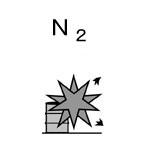| Case Name |
Explosion of benzene caused due to liquefied oxygen in surrounding air at a low temperature with liquid nitrogen |
| Pictograph |

|
| Date |
January 17, 1991 |
| Place |
Ibigawa, Gifu, Japan |
| Location |
Electronic parts factory |
| Overview |
Ceramics and solvents such as benzene were being freeze-dried using liquid nitrogen. Oxygen liquefied at a liquid nitrogen temperature of -196 °C and it reacted explosively with benzene in a freezing mixture. Although there have been ignition accidents caused due to inadequate mixing of liquid oxygen and flammables from using liquid nitrogen, no preventive measures were taken because of lack of knowledge of the accidents. |
| Incident |
New ceramics were being manufactured on trial at a ceramic substrate manufacturing factory. In the process of granulating ceramics, ceramic powder and a solvent such as benzene were stirred and mixed, liquid nitrogen at -196 °C was blown upon the mixture, it was freeze-dried, and ceramic particles were obtained. An explosion occurred when the particles were moved from a container to a butt with a stainless shovel, and put into a drier. |
| Processing |
Consumption and usage |
| Individual Process |
Mixing |
| Substance |
Benzene, Fig2 |
| Aluminum nitride, Fig3 |
| Nitrogen, Fig4 |
| Acrylic resin adhesives |
| Type of Accident |
Explosion |
| Sequence |
Ceramic powder was mixed with one ton of benzene, and was frozen with liquid nitrogen at -196 °C. Work for transferring the freezing mixture to another container using a scoop started. An explosion occurred at 14:15 on January 17th, 1991. |
| Cause |
It was assumed that oxygen was condensed at the liquid nitrogen temperature, and it reacted with benzene in the freezing mixture to form liquid oxygen explosives which explosively reacted. There had been similar accidents in the past. It is not clear whether the high density benzene vapor that filled the working chamber played any role in the accident. The ignition cause is assumed to be friction and impact during transferring work. |
| Response |
Urgent transportation of the injured. |
| Countermeasures |
1. Flammable solvents should not be used in a cooling process using liquid nitrogen.
2. The surface of liquid nitrogen should be isolated from the air.
3. Ignition sources such as mechanical stimulus and static electricity should be removed. |
| Knowledge Comment |
In a process using liquid nitrogen, oxygen in the air has danger of explosion if it is partially condensed, and is mixed with an organic substance. |
| Background |
The hazards of an explosive mixture with flammables being generated at liquid nitrogen temperature due to condensation of oxygen in the air have not been recognized. As it was a trial production process, detailed study and research might not have been carried out in advance. |
| Reason for Adding to DB |
Example of explosion caused due to liquid nitrogen of which the hazards are not well known |
| Scenario |
| Primary Scenario
|
Poor Value Perception, Poor Safety Awareness, Insufficient Safety Measure, Organizational Problems, Inflexible Management Structure, Insufficient Education/Training, Insufficient Analysis or Research, Insufficient Prior Research, Insufficient Study of Working Environment, Usage, Operation/Use, Usage Liquid Nitrogen, Bad Event, Chemical Phenomenon, Freezing, Bad Event, Chemical Phenomenon, Abnormal Reaction, Secondary Damage, External Damage, Explosion, Bodily Harm, Death, 2 person died, Bodily Harm, Injury
|
|
| Sources |
Fire and Disaster Management Agency, Explosion and fire which occurred when a liquid mixture containing benzene was moved in a container. Case study on accident with dangerous material. 1991, pp.306-309.
High Pressure Gas Safety Inst. of Japan. High-pressure gas protection overview. 1992 edition - pp.246, 252(1992).
Hidenori Matsui. Explosion hazard when handling liquid nitrogen. Safety engineering. No.172. pp.47-53(1993).
Kogaku Komamiya. Fire and explosion in the presence of excess oxygen. Safety engineering. No.203. pp.122-127(1998)
|
| Number of Deaths |
2 |
| Number of Injuries |
1 |
| Physical Damage |
All facilities of the factory including a ball mill mixer, a transfer pump, and an agitation vessel were damaged (Fire and Disaster Management Agency).
An adjacent factory was destroyed (High Pressure Gas Safety Inst. of Japan). A drier and a steel plate roof were destroyed. (Chunichi Shimbun). |
| Financial Cost |
¥ 7 million (Fire and Disaster Management Agency) |
| Multimedia Files |
Fig2.Chemical formula
|
|
Fig3.Chemical formula
|
|
Fig4.Chemical formula
|
| Field |
Chemicals and Plants
|
| Author |
WAKAKURA, Masahide (Kanagawa Industrial Technology Research Institute)
TAMURA, Masamitsu (Center for Risk Management and Safety Sciences, Yokohama National University)
|
|